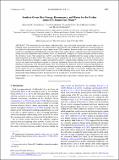Southern Ocean heat storage, reemergence, and winter sea ice decline induced by summertime winds
Author(s)
Doddridge, Edward W; Marshall, John; Song, Hajoon; Campin, Jean-Michel; Kelley, Maxwell
DownloadPublished version (4.710Mb)
Publisher Policy
Publisher Policy
Article is made available in accordance with the publisher's policy and may be subject to US copyright law. Please refer to the publisher's site for terms of use.
Terms of use
Metadata
Show full item recordAbstract
Ó 2021 American Meteorological Society. For information regarding reuse of this content and general copyright information, consult the AMS Copyright Policy The observational record shows a substantial 40-yr upward trend in summertime westerly winds over the Southern Ocean, as characterized by the southern annular mode (SAM) index. Enhanced summertime westerly winds have been linked to cold summertime sea surface temperature (SST) anomalies. Previous studies have suggested that Ekman transport or upwelling is responsible for this seasonal cooling. Here, another process is presented in which enhanced vertical mixing, driven by summertime wind anomalies, moves heat downward, cooling the sea surface and simultaneously warming the subsurface waters. The anomalously cold SSTs draw heat from the atmosphere into the ocean, leading to increased depth-integrated ocean heat content. The subsurface heat is returned to the surface mixed layer during the autumn and winter as the mixed layer deepens, leading to anomalously warm SSTs and potentially reducing sea ice cover. Observational analyses and numerical experiments support our proposed mechanism, showing that enhanced vertical mixing produces subsurface warming and cools the surface mixed layer. Nevertheless, the dominant driver of surface cooling remains uncertain; the relative importance of advective and mixing contributions to the surface cooling is model dependent. Modeling results suggest that sea ice volume is more sensitive to summertime winds than sea ice extent, implying that enhanced summertime westerly winds may lead to thinner sea ice in the following winter, if not lesser ice extent. Thus, strong summertime winds could precondition the sea ice cover for a rapid retreat in the following melt season.
Date issued
2021-01Department
Massachusetts Institute of Technology. Department of Earth, Atmospheric, and Planetary SciencesJournal
Journal of Climate
Publisher
American Meteorological Society
ISSN
0894-8755
1520-0442